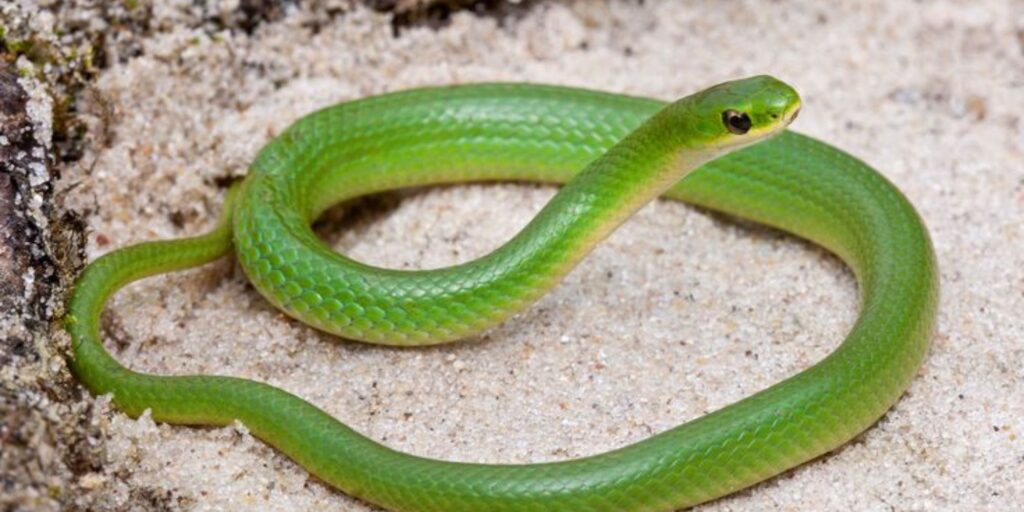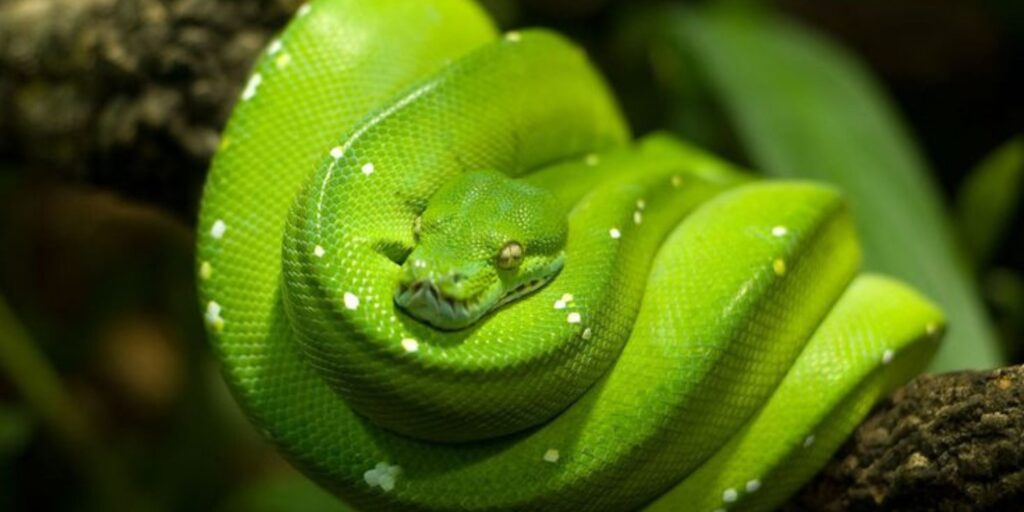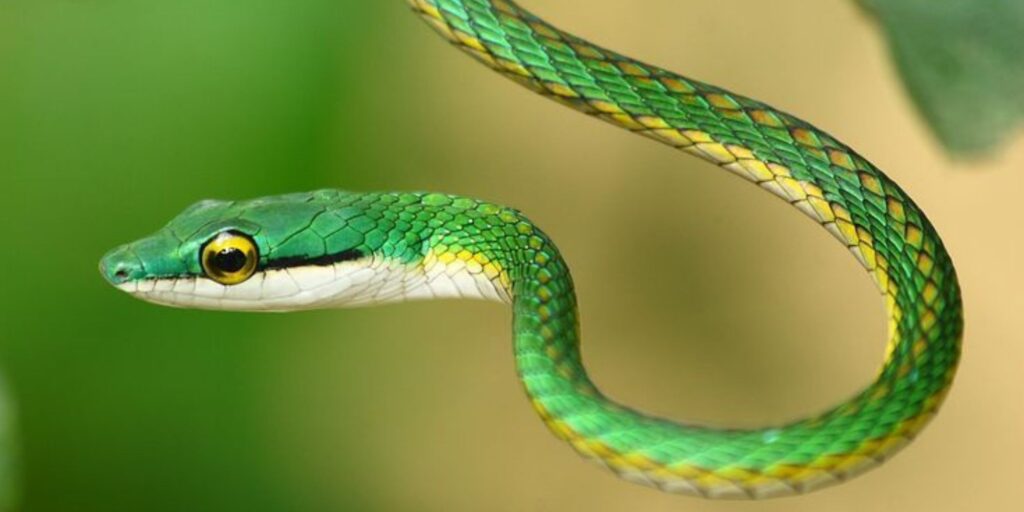Overview
Green snakes are fascinating creatures, easily recognized by their vibrant green color, which helps them blend seamlessly into their environments. Species like the smooth green snake and the eastern green mamba use this camouflage to hide in grass, trees, and shrubs, allowing them to avoid predators. Additionally, their color aids in hunting, as they silently approach their prey, which mainly consists of small insects and amphibians. Unlike many other snakes, green snakes are non-venomous, making them less of a threat to humans. In ecosystems, these snakes play an important role in controlling insect populations, helping maintain a balance in nature. However, green snakes face significant challenges, such as habitat loss and environmental changes. As their natural habitats shrink due to urban development and climate change, conservation efforts become increasingly important to ensure their survival. Protecting green snakes helps maintain the delicate balance of the ecosystems they inhabit.
Caring for Your Green Snake: A Guide for Enthusiasts and New Owners
Caring for a green snake requires attention to detail and dedication. These elegant creatures thrive in environments that mimic their natural habitats, so temperature and humidity are crucial factors. A secure enclosure with plenty of climbing opportunities will keep them happy and healthy.
Feeding your green snake is equally important. They generally prefer live or fresh prey, like insects or small rodents, depending on the subspecies. Regular feeding schedules help maintain their health while monitoring for any signs of illness ensures they stay vibrant and active throughout their lives.
Green Snake :Description
The green snake is a striking reptile, recognized for its vibrant, emerald-hued scales. Typically measuring between two to four feet long, depending on the species, this slender creature is both visually captivating and well-adapted to its environment. With smooth, bright-colored scales, it easily draws the attention of enthusiasts and nature lovers alike. Moreover, green snakes are primarily diurnal, meaning they are most active during daylight hours. As a result, they often blend seamlessly into their lush surroundings, using their vivid coloration as camouflage while hunting or basking in the sunlight. This camouflage is not just an aesthetic feature—it plays a crucial role in their survival, helping them avoid predators. Overall, the green snake’s appearance and behavior highlight its remarkable ability to thrive in its natural habitat, making it a fascinating subject of study for reptile enthusiasts and wildlife observers alike.
Green Snake :Subspecies
Green snakes are fascinating creatures, and they belong to several subspecies. Each one showcases unique characteristics that make them distinct from one another. For instance, the Eastern Smooth Green Snake is known for its vibrant coloration and docile nature, making it a popular choice among reptile enthusiasts.
On the other hand, the Northern Rough Green Snake has a more textured appearance due to its rough scales. This diversity in appearance and behavior adds intrigue for both new owners and seasoned experts alike as they explore their traits and habitats.
Green Snake :Etymology
The term “green snake” stems from the vibrant coloration that characterizes many species within this group. The name references their striking green hues, which offer excellent camouflage among foliage and trees.
Etymologically, the word “snake” originates from Old English “snaca,” which has roots in Proto-Germanic and Proto-Indo-European languages. This connection highlights a long-standing fascination with these reptiles across various cultures, emphasizing their significance in both nature and human understanding. Green snakes not only represent beauty but also intrigue us with their diverse behaviors and habitats.
Geographic Range
Green snakes are primarily found in North America, especially in the eastern and southeastern regions. Their range extends from southern Canada down to the Gulf Coast, thriving in various habitats like grasslands, forests, and wetlands.
Outside of North America, several species inhabit tropical areas around the world. The Asian vine snake can be spotted across Southeast Asia while others like the emerald tree boa dwell in Central and South America. This diversity highlights their adaptability to different environments globally.
Threats
Green snakes face a variety of threats in their natural habitats. Habitat destruction due to urbanization and agriculture is a significant concern. As humans expand into wild areas, these snakes lose not only their homes but also vital resources for survival.
Additionally, pollution poses serious risks to green snake populations. Contaminants can affect the health of these reptiles and disrupt their food sources. Climate change further complicates matters, altering ecosystems and making it harder for them to thrive in an ever-changing environment.
Conservation Status
The conservation status of green snakes varies significantly across different species. Some, like the Eastern Smooth Green Snake, face challenges due to habitat loss and human encroachment. These factors have led to declining populations in certain areas.
Others, such as the Emerald Tree Boa, are less threatened but still require vigilant monitoring. Conservation efforts are crucial for maintaining healthy ecosystems where these striking reptiles thrive. Protecting their habitats ensures that future generations can enjoy the beauty and diversity of green snakes around the world.
Habitat
Green snakes thrive in a variety of habitats, mainly favoring areas with plenty of vegetation. You’ll often find them in grassy fields, woodlands, and even near wetlands. Their affinity for dense foliage provides excellent camouflage against predators.
These snakes are mostly arboreal or terrestrial, depending on the species. Some prefer to climb trees while others stay close to the ground. This adaptability allows them to hunt effectively and evade threats in their surroundings. Understanding their habitat needs is essential for anyone looking to care for these beautiful creatures properly.
Behavior
Green snakes are known for their calm and docile nature. They tend to be shy, often hiding among leaves or in foliage to avoid detection. When threatened, they may freeze or blend into their surroundings rather than exhibit aggressive behavior.
These snakes are primarily diurnal, being most active during the day. They hunt insects and small prey with agile movements through trees and shrubs. Their gentle demeanor makes them a favorite among reptile enthusiasts, as they can be handled carefully without much stress or fear of aggression.
Reproduction
Green snakes exhibit fascinating reproductive behaviors. Most species are oviparous, laying eggs in hidden nests to protect them from predators. The female often seeks warm, moist environments that support the developing embryos.
After an incubation period of several weeks to months, hatchlings emerge ready to face the world. They typically measure around 10-12 inches long at birth and possess very similar traits as adults but require extra care during their early days. Understanding these reproductive patterns is essential for successful breeding in captivity or conservation efforts in the wild.
Identification

Green snakes are known for their vibrant coloration, showcasing shades of bright green to olive. Their smooth scales and slender bodies can make them appear almost iridescent in sunlight. Length varies by species, typically ranging from 2 to 5 feet long.
Distinctive features include a pointed snout and large eyes that provide excellent vision during the day. Unlike many other snake species, they lack any significant patterns or markings on their skin, allowing them to blend seamlessly into their leafy environments. This camouflage is vital for both hunting and avoiding predators.
Distribution & Habitat
Green snakes are primarily found in North America, particularly in areas with abundant vegetation. They prefer grasslands, wetlands, and forest edges where they can easily camouflage among the foliage. Their love for dense cover makes these habitats ideal for hunting and hiding from predators.
In contrast, some species like the Asian vine snake thrive in tropical climates across Southeast Asia. These habitats often include rainforests and shrublands that provide both food sources and ample places to hide. The diversity of green snake species reflects their adaptability to various environments around the globe.
Life Cycle
The life cycle of a green snake begins with the female laying eggs. Depending on the species, she usually deposits between 4 to 20 eggs in hidden locations such as leaf litter or rotting logs. The incubation period lasts around two months, during which temperature and humidity play critical roles.
Once hatched, baby green snakes are independent from day one. They quickly learn to hunt insects for food. As they grow, they must shed their skin multiple times—this molting process helps them accommodate their increasing size while maintaining healthy scales throughout their lives.
Current Threats, Status, and Conservation
Green snakes face several threats that impact their populations globally. Habitat loss due to urbanization, agriculture, and deforestation is the primary concern. These activities destroy essential environments where green snakes thrive, leading to a decline in their numbers.
Additionally, climate change poses risks through altered weather patterns and temperatures. Poaching for the exotic pet trade also contributes to their decreased populations. Conservation efforts are crucial to safeguard these unique serpents from further decline while promoting awareness about their ecological importance.
How to Help
Supporting green snake populations is crucial for their survival. You can help by educating yourself and others about these beautiful reptiles. Spread awareness of their ecological importance in controlling pest populations.
Participate in local conservation efforts or support organizations dedicated to protecting habitats. If you keep a green snake as a pet, ensure it is sourced from reputable breeders rather than the wild to prevent illegal capture. Every small action contributes positively to the future of these fascinating creatures.
11 Green Snake Species Slithering Around the Globe
The world is home to a fascinating array of green snake species. Each one showcases unique adaptations and characteristics. Among them, the Eastern Smooth Green Snake thrives in North America with its bright coloration, while the Western Smooth Green Snake prefers drier habitats.
In tropical regions, you’ll find the stunning Emerald Tree Boa and the elusive Asian Vine Snake. The African Boomslang stands out for its potent venom, making it an intriguing yet dangerous species. From tree canopies to marshy fields, these snakes exhibit remarkable diversity across their habitats.
Eastern Smooth Green Snake
The Eastern Smooth Green Snake is a charming species found primarily in the eastern regions of North America. Its vibrant green coloration allows it to blend seamlessly into its grassy surroundings, making it a true gem of the wild. This non-venomous snake typically reaches lengths between 20 to 30 inches, showcasing smooth scales that enhance its sleek appearance.
Eastern Smooth Green Snakes thrive in habitats rich with vegetation, such as meadows and wetlands. Their diet consists mainly of insects and other small invertebrates. Observing these gentle creatures can be a delightful experience for nature lovers and snake enthusiasts alike.
Western Smooth Green Snake
The Western Smooth Green Snake, scientifically known as Opheodrys vernalis, is a strikingly beautiful species. This snake boasts vibrant green scales that help it blend seamlessly into grassy habitats and fields. With its slender body reaching up to 30 inches in length, it is both agile and graceful.
Primarily found across the western United States and Canada, this non-venomous snake feeds on insects and other small invertebrates. Its gentle nature makes it a favorite among reptile enthusiasts. Understanding its habitat preferences can enhance your chances of spotting one in the wild or caring for one at home.
Northern Rough Green Snake
The Northern Rough Green Snake, or Opheodrys aestivus, is a striking addition to the green snake family. Found mainly in the eastern United States, its vibrant lime-green hue allows it to blend seamlessly with foliage. This adaptability offers it protection while hunting insects and small prey.
These snakes have a distinct rough texture due to their keeled scales. They are agile climbers and often inhabit areas near water sources like ponds or streams. Their docile nature makes them popular among reptile enthusiasts seeking a calm pet for their collection.
Florida Rough Green Snake
The Florida Rough Green Snake, known for its vibrant green color, is a non-venomous species native to the southeastern United States. These snakes are often found in lush vegetation and wetlands, where they blend seamlessly into their surroundings. Their slender bodies allow them to navigate through leaves with ease.
This species primarily feeds on insects and other small prey. They exhibit calm behavior and rarely threaten humans. With their striking appearance and gentle nature, Florida Rough Green Snakes make fascinating subjects for enthusiasts interested in observing these beautiful reptiles in their natural habitat.
Asian Vine Snake
The Asian Vine Snake, known for its slender body and vibrant green coloration, is a captivating reptile. This species thrives in Southeast Asia’s tropical forests, often seen hanging gracefully from branches. Its long, agile form helps it navigate through dense foliage with ease.
These snakes primarily feed on amphibians and lizards, using their keen eyesight to spot prey. Their unique ability to mimic the appearance of vines makes them effective ambush hunters. The Asian Vine Snake’s striking beauty and intriguing behavior make it a favorite among snake enthusiasts and wildlife observers alike.
Boomslang
The Boomslang, scientifically known as Dispholidus typus, is a highly intriguing green snake found primarily in sub-Saharan Africa. Renowned for its vibrant green coloration and distinctive large eyes, this species can often be spotted gliding gracefully through trees. The Boomslang’s diet mainly consists of birds and their eggs, showcasing its impressive hunting skills.
Despite being venomous, the Boomslang is generally not aggressive toward humans. It prefers to escape rather than confront threats. This elusive nature makes it a fascinating subject for herpetologists and wildlife enthusiasts alike who admire its beauty and unique adaptations.
Emerald Tree Boa
The Emerald Tree Boa is a striking species known for its vibrant green coloration and distinctive yellow or white markings. Native to the rainforests of South America, these snakes are primarily arboreal, spending most of their time coiled on tree branches. Their prehensile tails help them navigate through lush foliage with ease.
Emerald Tree Boas are non-venomous constrictors that prey mainly on small mammals and birds. They exhibit a unique hunting technique, waiting patiently until their target comes within range before striking swiftly. This captivating species is truly a marvel of nature’s design.
Eastern Green Mamba
The Eastern Green Mamba, native to the coastal regions of East Africa, captivates with its vibrant green hue. This stunning snake is primarily arboreal, preferring lush trees and dense foliage as its habitat. Its slender body allows for agile movements among branches.
Known for being reclusive, the Eastern Green Mamba usually avoids human interaction. However, if threatened, it can deliver a venomous bite that requires immediate medical attention. With keen eyesight and quick reflexes, this species is an adept hunter of small birds and rodents in its natural environment.
Green Tree Python

The Green Tree Python, known for its striking emerald color, is a captivating species native to the rainforests of New Guinea and nearby islands. These snakes are arboreal, expertly navigating through trees with their prehensile tails. Their vibrant appearance serves as excellent camouflage among foliage.
Growing up to six feet long, these pythons exhibit a range of colors from bright green to yellow or blue hues in specific subspecies. They are non-venomous constrictors that primarily feed on small mammals and birds, using their exceptional stealth to ambush unsuspecting prey from above.
Parrot Snake

The Parrot Snake is an intriguing species known for its striking appearance and vibrant colors. Native to Central and South America, it is often found in tropical forests where it blends seamlessly into its environment. This snake is non-venomous and primarily feeds on small reptiles and amphibians. Additionally, the Parrot Snake is arboreal, spending much of its time in trees, where its agility helps it navigate the branches with ease. Its unique coloration and behavior make it an interesting subject for both researchers and reptile enthusiasts. As we learn more about this species, it becomes clear how well it is adapted to its environment, contributing to the rich biodiversity of its habitat.
Western Green Mamba
The Western Green Mamba is a striking snake, known for its vibrant green color. Native to the coastal regions of West Africa, it thrives in lush forests with dense vegetation. While beautiful, this snake possesses potent venom that can be dangerous. Additionally, the Green Mamba is arboreal, spending most of its time in trees where it hunts small mammals and birds. Its agility allows it to move easily through branches. Understanding its habitat and behavior is essential for those studying or keeping them. Overall, the Western Green Mamba highlights the fascinating diversity of green snakes and the importance of learning about their unique traits to support conservation efforts.

